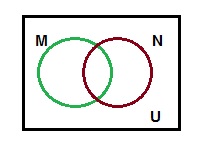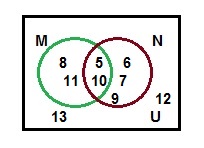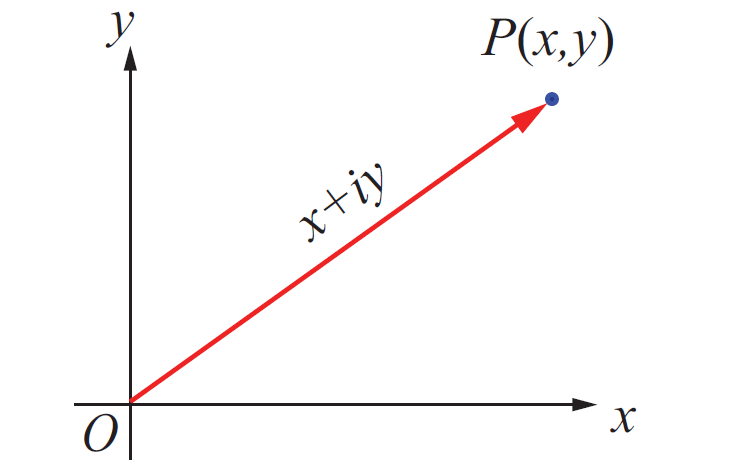UNION AND INTERSECTION PRACTICE PROBLEMS
Question 1 :
Place the elements of the following sets in the proper location on the given Venn diagram.

U = {5, 6, 7, 8, 9, 10, 11, 12, 13}
M = {5, 8, 10, 11}
N = {5, 6, 7, 9, 10}.
Solution :

Question 2 :
If A and B are two sets such that A has 50 elements, B has 65 elements and A∪B has 100 elements, how many elements in A∩B?
Solution :
Given n(A) = 50, n(B) = 65, n(A∪B) = 100
By the rule,
n(A∪B) = n(A) + n(B) - n(A∩B)
n(A∩B) = n(A) + n(B) - n(A∪B)
= 50+65-100
= 115-100
= 15
Question 3 :
If A and B are two sets containing 13 and 16 elements respectively, then find the minimum and maximum number of elements in A∪B?
Solution :
n(A) = 13 and n(B) = 16
n( A∪B) must be either the elements of the bigger set, that is B or the addition of number of elements in both A and B.
If A is the subset of B, then A∪B is the set B itself. Then the number of A∪B is number of B itself. That is the minimum number of A∪B.
So minimum of A∪B is 16.
If A and B are two disjoint sets, then number of elements in A∪B is the total number of elements in both A and B.
So, the maximum of A∪B is 13+16 = 29.
Question 4 :
If n( A∩B) = 5, n(A∪B) = 35, n(A) = 13, find n(B)?
Solution :
By the rule
n(A∪B) = n(A) + n(B) - n(A∩B)
n(B) = n(A∪B)+n(A∩B)-n(A)
= 35 + 5 - 13
n(B) = 27
Question 5 :
If n(A) = 26, n(B) = 10, n(A∪B) = 30, n(A') =17, find n(A∩B) and n(U)?
Solution :
n(A∪B) = n(A)+n(B)-n(A∩B)
n(A∩B) = n(A)+n(B)-n(A∪B)
n(A∩B) = 26+10-30
n(A∩B) = 6
n(A) + n(A') = n(U)
n(U) = 26+17
n(U) = 43
Question 6 :
If n(U) = 38, n(A) = 16, n(A∩B) = 12, n(B') = 20, find n(A∪B)?
Solution :
n(A) + n(A') = n(U)
n(B) = n(U)-n(B')
n(B) = 38 - 20
n(B) = 18
n(A∪B) = n(A)+n(B)- n(A∩B)
n(A∪B) = 16+18-12
n(A∪B) = 34-12
n(A∪B) = 22
Question 7 :
Let A and B be two finite sets such that n(A-B) = 30, n(A∪B) = 180, n(A∩B) = 60, find n(B)?
Solution :
n(A) = n(A-B) + n(AnB)
n(A) = 30+60
n(A) = 90
n(AuB) = n(A) + n(B) - n(AnB)
180 = 90 + n(B) - 60
180-30 = n(B)
n(B) = 150

Apart from the stuff given in this section, if you need any other stuff in math, please use our google custom search here.
Kindly mail your feedback to v4formath@gmail.com
We always appreciate your feedback.
©All rights reserved. onlinemath4all.com
Recent Articles
-
De Moivre's Theorem and Its Applications
Apr 19, 24 08:30 AM
De Moivre's Theorem and Its Applications -
First Fundamental Theorem of Calculus - Part 1
Apr 17, 24 11:27 PM
First Fundamental Theorem of Calculus - Part 1 -
Polar Form of a Complex Number
Apr 16, 24 09:28 AM
Polar Form of a Complex Number
